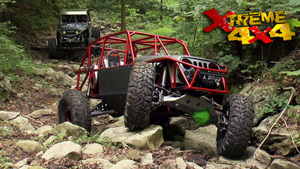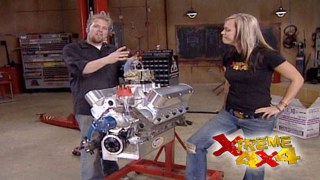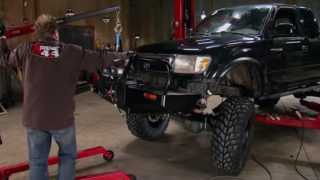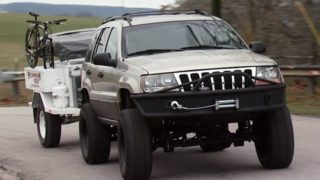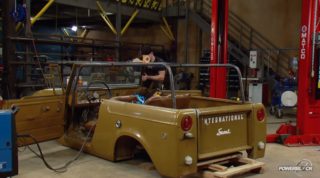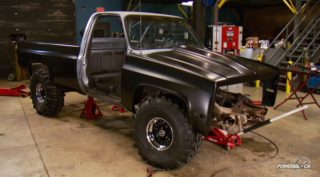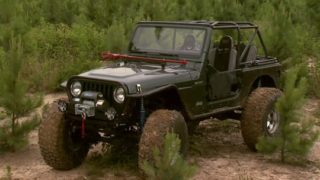More Trophy Truck Episodes
Xtreme 4x4 Builds
Want more content like this?
Join the PowerNation Email NewsletterParts Used In This Episode
Light Racing Tools
Dimple Dies, used for additional strengthтАжand looks.
Tube Works
17x8.5" Evolution Series wheels. What makes these dual integral beadlocks CORR legal is the outer flange being 1/2" thick and all the bolts and valve stems recessed below the rim surface for safety purposes.
Tube Works
Rear Axle with a 4" axle tube, .250 chromloy steel housing, upper and lower link mounts already installed, blade style rotors, hub kit, and Pro Am 6 piston calipers.
Episode Transcript
It's an off road racers guardian angel, the roll cage today. Life saving do s and don't as we get technical on our pro two race chassis plus lower budget doesn't mean less exciting short course racing. All right. Now on Xtreme 4x4.
Hey guys, welcome to Xtreme 4x4. And today we're gonna start putting together our core Pro two race track. Now, core racing has become hugely popular in the past couple of years,
partly because fans like you can sit in the stands and watch an entire race start to finish.
And also because of these wild machines that are tearing up tracks all across the states.
So building a race truck is very different than building a trail truck or a fun buggy. Number one, the details really do count a
small thing missed in this stage can be a serious accident out on the course, not just a day, fixing your own stuff on the trail. And second of all, you've got a rule book that you have to follow every single step
and you may look at our North American off-road built rolling chassis and think we're ready for a motor transmission, rear end, some wiring plumbing and ready to hit the track. But we're not, we got to deal with a whole bunch of little issues that are safety related and also little things that may come up during a race.
Now, the rear axle on our rolling chassis is from tube works and it has a four inch axle tube and fabricated center section all made out of 250,000 chrome Molly steel. Now, this thing is designed with one purpose and that is to survive serious off road abuse. Our link mounts and shock mounts were already installed by the guys at North American off road. But these rear uppers, they just seem to sit a little too tall.
I like that sound.
Ok? To work
with a cardboard template, bea
so we'll cut some gussets out of 0 90 chrome Molly flavor.
Now, all oddly required flared holes using our light racing flared hole. I
now this gusts that will add strength to this upper L mountain keep it from folding over during serious off road abuse because not only does it tie the two side pieces together, it also triangulates it off the tube itself. Now, the flared holes aren't there just to look good. They add structural integrity to the flat panel because of the three dimensional shape
to weld in the gusset. We're using er 70 S dash six welding rod
and 2% thord
tungsten in the tig torch
on the end of our housing, we're running tube works, new blade style rotor and hub kit, as well as a Pro
AM six piston caliper.
Now, the blade style rotor is designed to heat and cool a lot more efficiently as well as shed debris out of the brake system. So it doesn't get jammed up in the caliper causing the brakes to lock up. But the really unique feature of this system is how the rotor itself reacts to the t
heating and cooling cycle of a brake system.
Now, normally a rotor as it heats and cools will warp across its axis, causing a brake pulsation in the brakes and therefore limit their performance while the blade style rotor is designed to expand radially and contract the same. So you don't get that brake pedal pulsation and it won't limit your brakes on your 800 horsepower core truck
to deliver fluid into the rear rotors. A 316 steel brake line will come off the back side of the caliber
routing it close to the axle tube will help protect it during a race. A bulkhead fitting will be mounted beside the upper L
mountain.
So this is where we're gonna break from conventional race truck building. Normally you leave this rear axle housing in bare steel at the end of the race, you'd simply rub it down with some WD 40
inspect all the wells. But if you remember we're building this truck as a memorial truck for Jason Baldwin and the core sanctioning body and they're gonna take it around to tons of events for people to look at.
And after just one trip across the country on the truck, you can see it's got a bunch of scaling and rust building up on the back of the housing. We don't want this to happen, so we'll strip this housing down, paint it or powder coat it and then put it all back together. But that doesn't mean that we're gonna skimp on any heavy duty hardcore race parts for this project and that leads us to the wheels.
Now, core has some very specific rules that relate to the type of wheels you can put on your race truck and these are two works evolution series 17 by 8.5 core legal bead locks. And what makes them core legal is the outer bead lock flange must be a minimum of a half an inch thick as well as all the bead lock bolts, the valve stem and the wheel studs themselves need to be mounted below the face of the rim. And the reason they do that is just specifically for safety when this
hire and wheel hits another truck which it will in a race, you don't want to shear off those heads, the valve
stem or a wheel stud causing a wheel failure and therefore an accident. Now it's a true integral double be lock inside and out
and we have mounted on here a set of Toyo Open country MT.
Now, these are a street legal tire that a lot of core teams are actually running at the tracks. Now, we obviously haven't cut or grooved these yet. We're going to wait until we get to whatever track we're taking the truck to and do it. Then.
Now, the one area of our chassis that we wanna make sure stays intact no matter what is obviously the driver's compartment. Now to do that, we're gonna be adding gussets to all these tube intersections in this location of the chassis itself. Now, we have rules as well as pictures from the core tech department
that show us exactly where the gusts that need to go.
And although they might not look like much think of it like a snowshoe. If you step out into deep snow with just a boot on, you're going to go up to your knee. If you have a snowshoe on, you're distributing all your weight over a larger area, it will hold you up these work the exact same way by literally doubling the contact area of that tube
after the break.
See if this class seven rookie has the right stuff to make it to the big leagues
drama in the Illinois corn fields. When Xtreme 4x4 continues.
Hey guys, welcome back to Xtreme 4x4. Now, as you guys know, depending on where you live, different types of racing are hugely popular. West coast, desert racing, east coast rocks and mud. Well, in the Midwest where it's nice and flat. They have their own type of racing.
30 years ago, the cornfields around south central Illinois
cried out to the local four wheelers
or
the MidAmerica off road club answered the call, giving short track racers a place to strap in and get it on.
It's really good. It's really extreme, short course racing out here. It's really hardcore and real fast paced. You got 3, 10 lap heats of, you know, door to door action to compete.
These racers bring more than a set of wheels to the racetrack. You need nerves of steel for this kind of racing. It can't get pretty gnarly. You get
a little fender of it once in a while and short course racing, nothing intentional. Two guys fighting for positions, there's a little bumping and grinding. You gotta move them out of the way somehow. You know, you can't just say, hey move, you know, it ain't drive until you're scared and then push it just a little bit farther. We come here to run and run hard and we run hard, you know,
all the time.
Five classes of buggies and trucks came out to the season finale. Welcome to Lincoln Trails, Motorsports Stacy, Illinois, among the weekend warriors and series old timers. A kid has emerged in the truck class and dubbed
the One Extreme Close Up, huh? For Xtreme 4x4.
Just 22 years old rookie Justin Bremmer proved to be a natural by taking two overalls and four podiums in six events.
I just wanted to come out and watch this year and we hadn't planned on doing as good as we're doing. I surprised a lot of people in the first few races they say, are you sure you've never raced before? His all out racing style has been compared to core champion Carl Rene.
It's a driver's class. I mean, you gotta run your truck, you gotta be smart and his all business race space
intimidates the competition. My girlfriend doesn't like it because she say I get in my zone and I don't pay much attention to her, but I try to just focus on the race at the end of the day. I'll, I'll, I'll give her the attention she needs when them races are going on. I mean, that's all you're focused on on this day. Its focus was clinching the class seven title. I'd love to win the points race. I mean that,
that means a lot to me today. I have to finish. If I don't finish, I'm not gonna get
it.
Ernest Hemingway wrote by Guts. I mean, Grace under pressure
for Justin Bremmer.
This was gut check time
battling for third place in race one. Dirk Carlin didn't go easy on the rookie. Yeah,
I did. I
hit a little
harder than
I
gave him.
Little love
unfazed. The kid kept the veteran behind him all the way to the checker
I
got a lot of fans I owe it to because they make me push it a little bit harder than I want to. Sometimes with a third place in race two. Justin closed in on the title. We got one heat left. All I have to do is finish and I take the championship for the year as a rookie. A sure thing came apart on lap three. I gave it a little goose coming around this corner
over
here
and I heard it start slipping, completely lost everything.
When Justin's main point
rival, Tim
Schiff finished in second.
The official scores had to crunch some numbers.
I'm sweating right now. It's a little cool out. The breeze is blowing, but I'm still sweating. I wanted this bad. I wanted this real bad. I'm
not sure who won just yet. I'm gonna go find out here and hopefully it's good news. I don't know what to expect. Are
you sure you really want to do this? I
got
it.
It was a really close race and it comes down to just a few points
for 2nd and 3rd.
You won.
He's fast, he's smooth,
you know, he's doing all the right things. I think he's gonna be a good driver. One to look for in the, in the future. I am. The
Justin's gonna be a star. He's gonna be one of the good ones
when you got guys that have been racing for 1012, 15 years. Saying you're good. You're gonna be good. I mean, that's, that means a lot when you, when you hear that from veterans
next, never roll the dice. When building a roll cage tips you can live with when Xtreme 4x4 continues.
Welcome back to Xtreme 4x4. So far today, we've been going over some of the race specific parts required by our sanctioning body. We've added the required gussets to our roll cage to make sure this will pass tech and we've added some gussets to our rear axle just to be sure it's gonna last the entire race. Now, when you're building a full on race truck, it truly is an exercise in patience. Occasionally, you just have to look back at what you're building plan for the best case scenario, but you have to build this thing to handle the worst.
And when we're talking core things can get pretty bad
whether you swamp out on your own or you're caught up in the blender with 20 some odd other trucks. The only thing that's gonna keep you walking away from one of these wrecks is a well built roll cage.
Now, our complete rolling chassis was built by Tony Venlo at North American off road and he's been building serious hardcore off road race vehicles for almost as long as I've been alive. So we're very confident in the design of his roll cage. But this stack of papers right here.
All questions from you guys wanting to know basic rules for roll cage or chassis design. Are there any things that I have to do? And while there are, and since we're talking about safety as it relates to this roll cage, we thought it'd be a good time to take some time out and show you some basic cage rules.
Now, the first rule of thumb we wanna talk about is what's called intersect points. That basically means that whenever you have one tube hitting a main hoop or support, you need to carry that load on the exact opposite side throughout the chassis. And a good example is right here at the roof line, we have this vent pillar coming up and it's carried over the center of the chassis as well as this tube goes all the way back to the Roo frame rail with breaks in between. Now, these localized areas also create what's called heat nodes. So all your welding heat input is located in one centralized area. Now, this makes it a little bit stronger. But as you guys know, it's never the weld that breaks. It's always the metal right beside it. So if you think of it this way, if you had a tube in your roll cage that basically running straight, you brought in another tube into it from either the front or the rear
and you went ahead and brought the back tube to carry the load in and it was off center when you got in a wreck it's actually just gonna wanna fail and spin right by. If you carry that load on the exact opposite side, it's not gonna go anywhere. And to get a better idea of how all these rules play out when you're building a complete roll cage. I put together a mock up for you.
This is obviously the starting point for almost any roll cage. It's the main hoop inside the truck's cat. And the first thing you want to add is the belt bar to travel behind the seats and eventually be the attachment point for the seat belts
to do this. We add a tube at an angle to create triangulation
following the intersect rule of thumb. We need to continue this tube down to the frame rail on the opposite side of the belt tube.
Some would consider this overkill, but I think the small amount of weight it adds versus the strength.
It's a great idea to duplicate the crossbar on the opposite side.
Now that we know our main hoop is strong, it's time to move forward and protect the driver and the passenger. Now, there's three real distinct styles of roll cage to do this and we're going to show you all three on this one mocha.
Now, the first is what's called a halo bar. It's basically a hoop that travels from the main hoop out to the windshield.
Now, obviously, we need to support the front part of our halo bar and to do that. We're going to tie it into the frame by using a windshield and down tube.
It's going to come off the front corner and go down through the vehicle's floor. Now, this is not a very popular style of cage and off road, partly because any upward force that's placed on this tube here is hard to transfer into another tube that's tied in at such a steep angle on the halo itself. And that leads us to our next cage design.
Next,
we're going to build two distinctly different designs that share a lot of similarities.
Now, on this side, we basically pulled a page right out of a desert racing rule book. We have one single tube coming up from the frame past the windshield and back into the main hoop on the opposite side, similar design, but literally with a twist, comes up past the windshield turns and goes back into the main hoop itself. You see this a lot on trail trucks just visually more appealing
and they both have windshield bars and dash bars and they have all those intersect points that we were talking about before that car, all that load right back into the center of our main hoop. Now, the upper windshield tube is supported by two smaller bars that carry the load down eventually to the frame once the engine and transmission are put into place, and you could always add more triangulation into the doors themselves and even vent windows if the body style permits it. But all in all if you use any of these cage designs and the intersect point tips that we showed you today, you know, your cage
is gonna be safe.
Welcome back to Xtreme 4x4. So far today, we've been dealing with some safety issues required for our core Pro two race truck. And we also went ahead and built a mock up roll cage to give you guys a couple different roll cage designs for your own truck. And now we can tear back into our race chassis.
I didn't get the nut all the way off or not
to help keep track debris out of our driver's compartment. We're going to skin the cage around the driver with 0 90 aluminum.
The rules require at least 0 75
but the 0 90 will not add that much weight.
The entire roof needs to be skinned the same
as well as under the fuel cell to keep it from being punctured.
And this is another area where a race truck differs a lot from a trail truck. Most trail trucks you'll see out there, the body panels are trimmed to fit into the tube opening. But having this large sheet bolted on here actually makes it stronger and safer for the driver. But now we got to go through this entire chassis and make all the panels to protect the driver when he's out on the track. But you don't want to watch us do that. You wanna watch us do this.
That's good.
Now, since the day has been all about safety, we showed you a bunch of different things
that relate to race trucks
and trail trucks and built this mock up cage.
But the last thing we should do
test it
and that's strong.
Show Full Transcript
Hey guys, welcome to Xtreme 4x4. And today we're gonna start putting together our core Pro two race track. Now, core racing has become hugely popular in the past couple of years,
partly because fans like you can sit in the stands and watch an entire race start to finish.
And also because of these wild machines that are tearing up tracks all across the states.
So building a race truck is very different than building a trail truck or a fun buggy. Number one, the details really do count a
small thing missed in this stage can be a serious accident out on the course, not just a day, fixing your own stuff on the trail. And second of all, you've got a rule book that you have to follow every single step
and you may look at our North American off-road built rolling chassis and think we're ready for a motor transmission, rear end, some wiring plumbing and ready to hit the track. But we're not, we got to deal with a whole bunch of little issues that are safety related and also little things that may come up during a race.
Now, the rear axle on our rolling chassis is from tube works and it has a four inch axle tube and fabricated center section all made out of 250,000 chrome Molly steel. Now, this thing is designed with one purpose and that is to survive serious off road abuse. Our link mounts and shock mounts were already installed by the guys at North American off road. But these rear uppers, they just seem to sit a little too tall.
I like that sound.
Ok? To work
with a cardboard template, bea
so we'll cut some gussets out of 0 90 chrome Molly flavor.
Now, all oddly required flared holes using our light racing flared hole. I
now this gusts that will add strength to this upper L mountain keep it from folding over during serious off road abuse because not only does it tie the two side pieces together, it also triangulates it off the tube itself. Now, the flared holes aren't there just to look good. They add structural integrity to the flat panel because of the three dimensional shape
to weld in the gusset. We're using er 70 S dash six welding rod
and 2% thord
tungsten in the tig torch
on the end of our housing, we're running tube works, new blade style rotor and hub kit, as well as a Pro
AM six piston caliper.
Now, the blade style rotor is designed to heat and cool a lot more efficiently as well as shed debris out of the brake system. So it doesn't get jammed up in the caliper causing the brakes to lock up. But the really unique feature of this system is how the rotor itself reacts to the t
heating and cooling cycle of a brake system.
Now, normally a rotor as it heats and cools will warp across its axis, causing a brake pulsation in the brakes and therefore limit their performance while the blade style rotor is designed to expand radially and contract the same. So you don't get that brake pedal pulsation and it won't limit your brakes on your 800 horsepower core truck
to deliver fluid into the rear rotors. A 316 steel brake line will come off the back side of the caliber
routing it close to the axle tube will help protect it during a race. A bulkhead fitting will be mounted beside the upper L
mountain.
So this is where we're gonna break from conventional race truck building. Normally you leave this rear axle housing in bare steel at the end of the race, you'd simply rub it down with some WD 40
inspect all the wells. But if you remember we're building this truck as a memorial truck for Jason Baldwin and the core sanctioning body and they're gonna take it around to tons of events for people to look at.
And after just one trip across the country on the truck, you can see it's got a bunch of scaling and rust building up on the back of the housing. We don't want this to happen, so we'll strip this housing down, paint it or powder coat it and then put it all back together. But that doesn't mean that we're gonna skimp on any heavy duty hardcore race parts for this project and that leads us to the wheels.
Now, core has some very specific rules that relate to the type of wheels you can put on your race truck and these are two works evolution series 17 by 8.5 core legal bead locks. And what makes them core legal is the outer bead lock flange must be a minimum of a half an inch thick as well as all the bead lock bolts, the valve stem and the wheel studs themselves need to be mounted below the face of the rim. And the reason they do that is just specifically for safety when this
hire and wheel hits another truck which it will in a race, you don't want to shear off those heads, the valve
stem or a wheel stud causing a wheel failure and therefore an accident. Now it's a true integral double be lock inside and out
and we have mounted on here a set of Toyo Open country MT.
Now, these are a street legal tire that a lot of core teams are actually running at the tracks. Now, we obviously haven't cut or grooved these yet. We're going to wait until we get to whatever track we're taking the truck to and do it. Then.
Now, the one area of our chassis that we wanna make sure stays intact no matter what is obviously the driver's compartment. Now to do that, we're gonna be adding gussets to all these tube intersections in this location of the chassis itself. Now, we have rules as well as pictures from the core tech department
that show us exactly where the gusts that need to go.
And although they might not look like much think of it like a snowshoe. If you step out into deep snow with just a boot on, you're going to go up to your knee. If you have a snowshoe on, you're distributing all your weight over a larger area, it will hold you up these work the exact same way by literally doubling the contact area of that tube
after the break.
See if this class seven rookie has the right stuff to make it to the big leagues
drama in the Illinois corn fields. When Xtreme 4x4 continues.
Hey guys, welcome back to Xtreme 4x4. Now, as you guys know, depending on where you live, different types of racing are hugely popular. West coast, desert racing, east coast rocks and mud. Well, in the Midwest where it's nice and flat. They have their own type of racing.
30 years ago, the cornfields around south central Illinois
cried out to the local four wheelers
or
the MidAmerica off road club answered the call, giving short track racers a place to strap in and get it on.
It's really good. It's really extreme, short course racing out here. It's really hardcore and real fast paced. You got 3, 10 lap heats of, you know, door to door action to compete.
These racers bring more than a set of wheels to the racetrack. You need nerves of steel for this kind of racing. It can't get pretty gnarly. You get
a little fender of it once in a while and short course racing, nothing intentional. Two guys fighting for positions, there's a little bumping and grinding. You gotta move them out of the way somehow. You know, you can't just say, hey move, you know, it ain't drive until you're scared and then push it just a little bit farther. We come here to run and run hard and we run hard, you know,
all the time.
Five classes of buggies and trucks came out to the season finale. Welcome to Lincoln Trails, Motorsports Stacy, Illinois, among the weekend warriors and series old timers. A kid has emerged in the truck class and dubbed
the One Extreme Close Up, huh? For Xtreme 4x4.
Just 22 years old rookie Justin Bremmer proved to be a natural by taking two overalls and four podiums in six events.
I just wanted to come out and watch this year and we hadn't planned on doing as good as we're doing. I surprised a lot of people in the first few races they say, are you sure you've never raced before? His all out racing style has been compared to core champion Carl Rene.
It's a driver's class. I mean, you gotta run your truck, you gotta be smart and his all business race space
intimidates the competition. My girlfriend doesn't like it because she say I get in my zone and I don't pay much attention to her, but I try to just focus on the race at the end of the day. I'll, I'll, I'll give her the attention she needs when them races are going on. I mean, that's all you're focused on on this day. Its focus was clinching the class seven title. I'd love to win the points race. I mean that,
that means a lot to me today. I have to finish. If I don't finish, I'm not gonna get
it.
Ernest Hemingway wrote by Guts. I mean, Grace under pressure
for Justin Bremmer.
This was gut check time
battling for third place in race one. Dirk Carlin didn't go easy on the rookie. Yeah,
I did. I
hit a little
harder than
I
gave him.
Little love
unfazed. The kid kept the veteran behind him all the way to the checker
I
got a lot of fans I owe it to because they make me push it a little bit harder than I want to. Sometimes with a third place in race two. Justin closed in on the title. We got one heat left. All I have to do is finish and I take the championship for the year as a rookie. A sure thing came apart on lap three. I gave it a little goose coming around this corner
over
here
and I heard it start slipping, completely lost everything.
When Justin's main point
rival, Tim
Schiff finished in second.
The official scores had to crunch some numbers.
I'm sweating right now. It's a little cool out. The breeze is blowing, but I'm still sweating. I wanted this bad. I wanted this real bad. I'm
not sure who won just yet. I'm gonna go find out here and hopefully it's good news. I don't know what to expect. Are
you sure you really want to do this? I
got
it.
It was a really close race and it comes down to just a few points
for 2nd and 3rd.
You won.
He's fast, he's smooth,
you know, he's doing all the right things. I think he's gonna be a good driver. One to look for in the, in the future. I am. The
Justin's gonna be a star. He's gonna be one of the good ones
when you got guys that have been racing for 1012, 15 years. Saying you're good. You're gonna be good. I mean, that's, that means a lot when you, when you hear that from veterans
next, never roll the dice. When building a roll cage tips you can live with when Xtreme 4x4 continues.
Welcome back to Xtreme 4x4. So far today, we've been going over some of the race specific parts required by our sanctioning body. We've added the required gussets to our roll cage to make sure this will pass tech and we've added some gussets to our rear axle just to be sure it's gonna last the entire race. Now, when you're building a full on race truck, it truly is an exercise in patience. Occasionally, you just have to look back at what you're building plan for the best case scenario, but you have to build this thing to handle the worst.
And when we're talking core things can get pretty bad
whether you swamp out on your own or you're caught up in the blender with 20 some odd other trucks. The only thing that's gonna keep you walking away from one of these wrecks is a well built roll cage.
Now, our complete rolling chassis was built by Tony Venlo at North American off road and he's been building serious hardcore off road race vehicles for almost as long as I've been alive. So we're very confident in the design of his roll cage. But this stack of papers right here.
All questions from you guys wanting to know basic rules for roll cage or chassis design. Are there any things that I have to do? And while there are, and since we're talking about safety as it relates to this roll cage, we thought it'd be a good time to take some time out and show you some basic cage rules.
Now, the first rule of thumb we wanna talk about is what's called intersect points. That basically means that whenever you have one tube hitting a main hoop or support, you need to carry that load on the exact opposite side throughout the chassis. And a good example is right here at the roof line, we have this vent pillar coming up and it's carried over the center of the chassis as well as this tube goes all the way back to the Roo frame rail with breaks in between. Now, these localized areas also create what's called heat nodes. So all your welding heat input is located in one centralized area. Now, this makes it a little bit stronger. But as you guys know, it's never the weld that breaks. It's always the metal right beside it. So if you think of it this way, if you had a tube in your roll cage that basically running straight, you brought in another tube into it from either the front or the rear
and you went ahead and brought the back tube to carry the load in and it was off center when you got in a wreck it's actually just gonna wanna fail and spin right by. If you carry that load on the exact opposite side, it's not gonna go anywhere. And to get a better idea of how all these rules play out when you're building a complete roll cage. I put together a mock up for you.
This is obviously the starting point for almost any roll cage. It's the main hoop inside the truck's cat. And the first thing you want to add is the belt bar to travel behind the seats and eventually be the attachment point for the seat belts
to do this. We add a tube at an angle to create triangulation
following the intersect rule of thumb. We need to continue this tube down to the frame rail on the opposite side of the belt tube.
Some would consider this overkill, but I think the small amount of weight it adds versus the strength.
It's a great idea to duplicate the crossbar on the opposite side.
Now that we know our main hoop is strong, it's time to move forward and protect the driver and the passenger. Now, there's three real distinct styles of roll cage to do this and we're going to show you all three on this one mocha.
Now, the first is what's called a halo bar. It's basically a hoop that travels from the main hoop out to the windshield.
Now, obviously, we need to support the front part of our halo bar and to do that. We're going to tie it into the frame by using a windshield and down tube.
It's going to come off the front corner and go down through the vehicle's floor. Now, this is not a very popular style of cage and off road, partly because any upward force that's placed on this tube here is hard to transfer into another tube that's tied in at such a steep angle on the halo itself. And that leads us to our next cage design.
Next,
we're going to build two distinctly different designs that share a lot of similarities.
Now, on this side, we basically pulled a page right out of a desert racing rule book. We have one single tube coming up from the frame past the windshield and back into the main hoop on the opposite side, similar design, but literally with a twist, comes up past the windshield turns and goes back into the main hoop itself. You see this a lot on trail trucks just visually more appealing
and they both have windshield bars and dash bars and they have all those intersect points that we were talking about before that car, all that load right back into the center of our main hoop. Now, the upper windshield tube is supported by two smaller bars that carry the load down eventually to the frame once the engine and transmission are put into place, and you could always add more triangulation into the doors themselves and even vent windows if the body style permits it. But all in all if you use any of these cage designs and the intersect point tips that we showed you today, you know, your cage
is gonna be safe.
Welcome back to Xtreme 4x4. So far today, we've been dealing with some safety issues required for our core Pro two race truck. And we also went ahead and built a mock up roll cage to give you guys a couple different roll cage designs for your own truck. And now we can tear back into our race chassis.
I didn't get the nut all the way off or not
to help keep track debris out of our driver's compartment. We're going to skin the cage around the driver with 0 90 aluminum.
The rules require at least 0 75
but the 0 90 will not add that much weight.
The entire roof needs to be skinned the same
as well as under the fuel cell to keep it from being punctured.
And this is another area where a race truck differs a lot from a trail truck. Most trail trucks you'll see out there, the body panels are trimmed to fit into the tube opening. But having this large sheet bolted on here actually makes it stronger and safer for the driver. But now we got to go through this entire chassis and make all the panels to protect the driver when he's out on the track. But you don't want to watch us do that. You wanna watch us do this.
That's good.
Now, since the day has been all about safety, we showed you a bunch of different things
that relate to race trucks
and trail trucks and built this mock up cage.
But the last thing we should do
test it
and that's strong.







